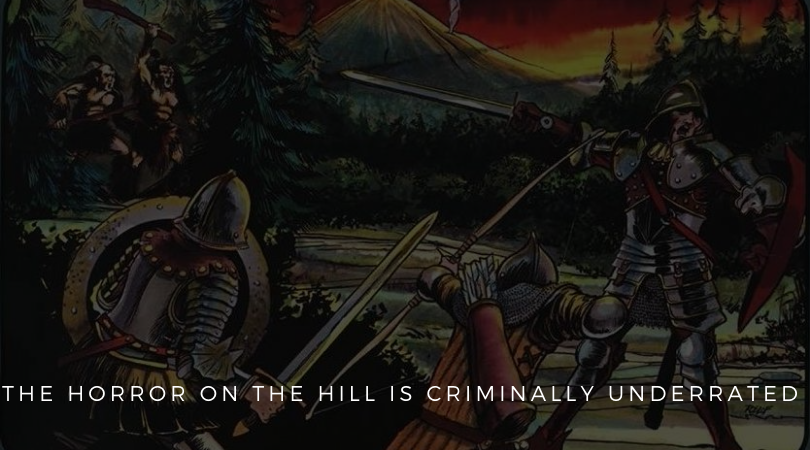The Horror on the Hill is Criminally Underrated

I have many, many happy memories of running B5 Horror on the Hill. I think it is almost as good as its much more famous brethren B2 Keep on the Borderlands.
I’ve always been surprised the module doesn’t feature in more “good design” and “good adventure” style posts and articles. It didn’t even make Paizo’s Top 30 in Dungeon 116. In my opinion, it’s a spectacular example of a well designed low-level dungeon. (It’s not perfect, though, as I’ll discuss below).
Horror on the Hill has been on my mind a lot recently. It's the setting of my Against the Darkness Ashlar campaign, and I would love to design a similar adventure. I've had tremendous fun tweaking and adding details and location to the module, which has reawoken my lust to write a full-sized adventure.
The Good
There is a lot to like about this criminally underrated module.
It’s a Whopper
Douglas Niles packs an epic amount of material into the module’s 32 pages. Putting aside the introduction text, three new monsters and so on we get a large wilderness “level”, the ruined monastery’s ruined upper works and three dungeon levels.In all, we get 101 encounter areas. You could run this module for months. (And I have). When I last ran it, we got 49 sessions out of a 32-page module. That's an amazing "bang for your buck".
It’s Got Different Zones & Challenges
Each level features different foes and challenges.
The wilderness (and as I’ve said before all good dungeons need a wilderness) features lots of animals while other encounters foreshadow what the characters will find in the monastery. The characters can also get lost in the densely forested hills which means they might experience more of the great outdoors than they had planned! Even reaching the ruins is an achievement.
The ruined monastery level and the first dungeon level feature undead as well as goblins and hobgoblins along with their servants, slaves and allies.
The second dungeon level—a confusing maze of natural caverns—hosts a mix of creatures who have become trapped in the level including dungeon scavengers and so on.
The final level also comprises natural caverns, but here a red dragon holds sway while a kobold tribe claims part of the level. There is but one way out—through the red dragon’s lair. This is the adventure's climactic encounter.
Change of Pace
For the first two levels of the adventure, the characters are in control; they can decide when and where to strike. However, if they get trapped in the second dungeon level, that changes. From that point onwards, they cannot go back. They must go forward, with the resources they have on hand. (See, I told you resource management was cool). The whole tenor of the module changes, and the tension ratchets up.
The Ruins Feel Alive
A good dungeon doesn’t just exist in stasis waiting for adventures to come and kill everything living in it (except, perhaps, for certain ancient tombs and barrow mounds). Things are happening in the monastery. For example, in location 51, the characters come across a party of dead adventurers still protected by their trained wolves. This encounter is also cool because the characters might be able to add two trained wolves to the party! (And who doesn’t want that?)
Later on, the characters may find the body of a long-dead adventurer and claim a magic sword which will be tremendously handy against the aforementioned red dragon.
The Bad
Horror on the Hill is good, but it’s not perfect. Several things don’t work for me. These include:
Mysterious Spellcasters
A “small cottage”, although not all is as it appears, lies in the woods. Two powerful spellcasters—kindly little old ladies—live in the cottage filled with treasure that disintegrates if stolen. I’m paraphrasing, but essentially the encounter sucks. It’s my least favourite bit of the whole module and I ignore it as I think it kills the mood.
Odd Verisimilitude
I love verisimilitude. I live and breathe it whenever I can. I love how a lot of the module's monsters and challenges make sense in regards to the location in which they appear.
That said, I’m not a huge fan of the presence of the neanderthals in various locations in the module; it just doesn't make sense to me. I know this makes no sense when you consider the many fantastical creatures that do appear in the module but what can you do? I think—for me—they have too much “real world” historical baggage. (I have similar views on dinosaurs in my games, except in certain defined environments).
Only One Way In
In regards to the module's dungeon levels, each has only one way in. There is only one way into dungeon level 1. There is only one way into dungeon level 2 and—you guessed it—there is only one way into dungeon level 3. That’s a major flaw in the module as it forces the characters through certain defined “checkpoints” and reduces their freedom to make meaningful choices. A good dungeon—or dungeon level—needs more than one way in.
No Home Base
One of the great things about Keep on the Borderland—shockingly—is the keep. While Horror on the Hillhas Guido’s Fort the details of said fort could charitably be described as scanty. I would have loved a handful of pages devoted to the characters’ base.
The Final Word
B5 Horror on the Hill is a fantastic module and a must-own addition to any D&D or Pathfinder GM's library. I've run the adventure in Basic, 3rd edition, Pathfinder 1st edition and 5e D&D. It worked splendidly in all its different "flavours", and is tremendously easy to convert.
What Do You Think?
Have you run Horror on the Hill? Love it? Hate it? Did I miss anything? Sign up for a full Gameatory account, join our exclusive Slack channel and let me know!

Member discussion